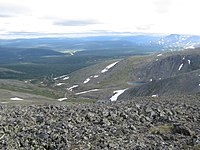
Photo from wikipedia
The objective of this study was to compare eco-physiological and morphological parameters of a regionally endangered orchid species, Epipactis atrorubens (Hoffm. ex Bernh.) Bess., growing in two forest communities (on… Click to show full abstract
The objective of this study was to compare eco-physiological and morphological parameters of a regionally endangered orchid species, Epipactis atrorubens (Hoffm. ex Bernh.) Bess., growing in two forest communities (on serpentine and granite outcrops) of the Middle Urals, Russia. Biodiversity, dominance, and phytocoenosis studies showed the colonization of a wide range of plant species on both sites. The physicochemical properties of the soil, chemical composition and morphological features of E. atrorubens, growing under technogenic conditions (asbestos deposits), on serpentine outcrops and in the natural environment of the granite massif were studied for the first time. The serpentine substrate differed from the granite one by its greater stoniness, circumneutral pH and lower contents of available nitrogen and phosphorus. Extremely high concentrations of magnesium were found in the serpentine soil, some 79 times higher than in the granite substrate. High concentrations of nickel (94 times), chromium (59 times), cobalt (17 times), and iron (4 times) were found in the serpentine substrate, higher than in the granite substrate. The differences between the sites for available metal contents and for root and shoot metal contents were significantly less. Concentrations of most of the metals in the roots were higher than in the shoots. Despite higher metal concentrations and lower nitrogen and phosphorus levels in serpentine soils, E. atrorubens had a larger population and greater viability compared to those growing on granite. Plants on serpentine outcrops were characterized by the formation of a larger number of fruits, greater root lengths and thicker leaf blades, compared to plants on granites. The well-developed orchid mycorrhizae contributed to the survival of this species under unfavorable serpentine conditions. Hence, serpentine outcrops formed due to the mining of asbestos could be a suitable substrate for the light-demanding E. atrorubens due to its capacity to adapt to dry, rocky, nutrient-depleted soils and limited competition from other plants.
Journal Title: Journal of Forestry Research
Year Published: 2019
Link to full text (if available)
Share on Social Media: Sign Up to like & get
recommendations!